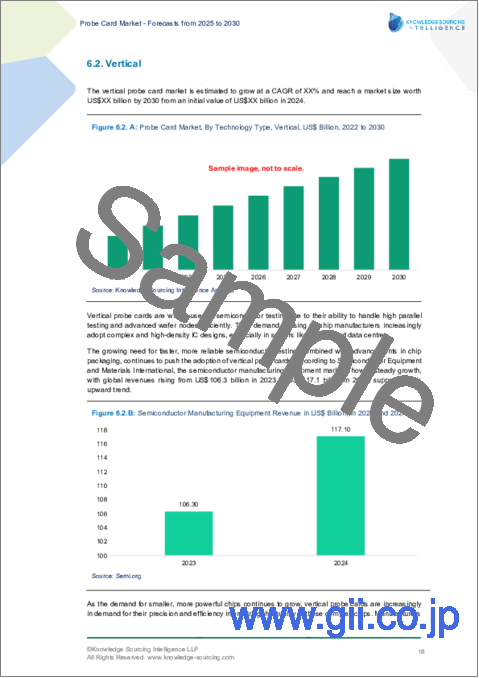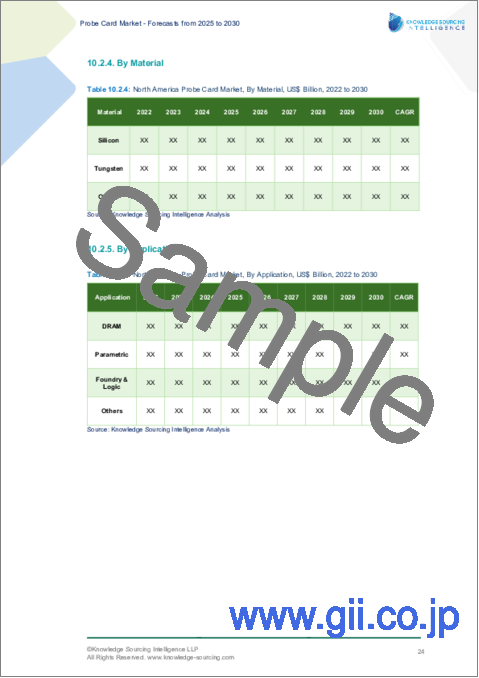|
|
市場調査レポート
商品コード
1496045
プローブカード市場:2024年~2029年の予測Probe Card Market - Forecasts from 2024 to 2029 |
||||||
カスタマイズ可能
|
|||||||
| プローブカード市場:2024年~2029年の予測 |
|
出版日: 2024年05月14日
発行: Knowledge Sourcing Intelligence
ページ情報: 英文 145 Pages
納期: 即日から翌営業日
|
全表示
- 概要
- 目次
プローブカード市場の2022年の市場規模は26億5,100万米ドルと推定され、CAGR 9.21%で成長し、2029年には市場規模は49億1,200万米ドルに達します。
プローブカード市場は、予測期間中に着実な成長を見せると予測されています。プローブカードは、電子チップの製造過程でチップの評価に使用されるハイテック電子機器です。チップはシリコンと呼ばれる薄い半導体材料でできています。プローブカードは、チップの動作をウエハー上または個別梱包前に評価するための電気機械的ゲートウェイとして機能します。
プローブカードは、チップの機械的、電気的要求の下で構築されます。プローブカードは、針型、垂直型、微小電気機械システム(MEMS)の3種類に分類されます。先端技術の増加、半導体産業への需要の高まり、半導体分野への投資の増加がプローブカード市場の成長を牽引しています。
プローブカード市場促進要因
- 先端技術の増加がプローブカード市場の成長を牽引
5G、AI、自律走行、モノのインターネット(IoT)などの新技術の台頭が半導体の利用を押し上げ、結果としてプローブカード市場の成長を牽引しています。リアルなグラフィックス、AI、自動運転車、データセンターなどの高度なアプリケーションでは、効率的なパフォーマンスが求められています。上記の技術には、迅速なテスト目的のために高度なプローブ・カードが必要とされる、面倒で高速性能のチップが含まれます。
従来型のプローブカードは性能面で苦戦を強いられており、これらの新しいプローブカードは、高品質でよく開発された次世代半導体の開発に歩調を合わせています。技術的なアップグレードは、より高速で、より強力で、低エネルギー消費のチップを必要とするため、効果的なテストのための洗練されたプローブカードの実践を余儀なくされます。
- 半導体産業の普及がプローブカード市場の成長を促進
携帯電話やノートパソコンなどの民生用電子機器の使用頻度が高まっていることが、半導体への追加的な要求を後押ししています。これらの電子機器の複雑さが増すにつれて、生産性の高いテスト手順が求められています。プローブカードは、集積回路を包装して流通させる前に、その優位性と機能性を保証するため、プロトコルにおいて重要な役割を果たしています。
メーカー各社は、複雑なディテールやピン数の増加、ウエハー上の繊細な構造を扱うための機能を強化したプローブカードを開発するため、技術革新を優先しています。これにより、現代の電子機器のシームレスな動作に不可欠な、高度なICの正確なテストが保証されます。
例えば、2023年のSemiconductor Industry Associationに掲載された記事によると、2023年、日常的な技術の利用の増加により、半導体の重要性は急上昇しています。2022年には世界で10億個の半導体が販売されました。
- 半導体分野への投資の増加は、プローブカード市場の成長を促進します。
集積回路の需要増は、半導体メーカーが生産設備を幅広く拡張することを後押ししています。こうした拡張には試験設備の設置に膨大な投資が必要となるため、プローブカードは重要な役割を果たします。
半導体メーカーが集積回路の生産量を増やすにつれ、チップの品質を最優先することが極めて重要になります。プローブカードは、検査装置とウエハーとの電気的接続を確立するために不可欠なコンポーネントであり、チップのパッケージング前の前工程です。検査プロセスへの投資と半導体製造センターの設立は、集積回路の品質向上のために互いに連携しています。
例えば、2023年12月にPress Information Bureauが発表した記事によると、米国政府はマイクロンによる22,516クロー(27億5,000万米ドル)の設備投資を伴う半導体ユニットの設立を承認しました。
プローブカード市場- 地理的展望
- アジア太平洋地域は大幅な成長が見込まれます。
アジア太平洋地域は、韓国、台湾、日本の半導体メーカーが最も多く、プローブカード市場の成長を後押ししています。また、同地域はモバイル機器やウェアラブルなどの家電製品が最も多く、製造工程でこれらの機器に使用される検査済みチップの大きな基盤となっています。
各国政府は、国内でのチップ生産を可能にするため、またプローブカードのような検査機器を強化するため、地域のチップ製造業を後押しするイニシアチブを取っています。
例えば、2023年11月に世界経済フォーラムが発表した記事によると、日本政府は半導体の国内生産を強化するために130億米ドルの資金を提供し、半導体産業を後押ししています。
プローブカード市場の抑制要因
- 膨大な投資がプローブカード市場の成長を抑制します。
高度な機能を備えた複雑な新しいプローブカードの製造と作成は、製造の導入部分として高額となる投資を強化する可能性があります。チップ設計の絶え間ない進化を伴うため、困難で高コストとなります。
- 技術的な問題の増大がプローブカード市場の成長を阻害する可能性があります。
チップの小型化と複雑化により、プローブカードはチップパッドとの正確な位置合わせと接触が課題となっています。これは、損傷や誤ったアライメントにつながる可能性があり、テスト時の精度に影響を与えます。
プローブカード市場の主な業界開拓
- 2023年11月テラダインとテクノフォビアは、半導体テストインターフェイスのイノベーションを推進し、急成長を促進することを目的とした提携を発表しました。この提携はチップテスト市場において両社を支援します。
プローブカード市場プレーヤーと製品
- MTシリーズ:日本エレクトロニクスマテリアルズが提供する製品は、特に小さな銅ピラーバンプやパッドを含むフリップチップのテスト用に設計されたMEMS プローブカードです。MEMS(Micro Electromechanical Systems)と薄膜多層膜を組み込んだ先進技術により、高精度な検査が可能。
- V93000:アドバンテスト社の製品で、半導体の評価に特化しています。本製品は、様々なサイズに対応する柔軟なソリューションを提供するため、異なる特殊機能を持つ様々なモデルを用意しています。
- HFTAPシリーズ:フォームファクターが提供するこの製品は、ダイナミック・ランダム・アクセス・メモリ(DRAM)デバイスを高速でテストするために特別に設計された最先端のプローブ・ソリューションです。先進的なPCB技術を活用し、最大3.2GHzの速度に達することができるため、効率的なチップテストシリーズを実現します。
目次
第1章 イントロダクション
- 市場概要
- 市場の定義
- 調査範囲
- 市場セグメンテーション
- 通貨
- 前提条件
- 基準年と予測年のタイムライン
- ステークホルダーにとっての主なメリット
第2章 調査手法
- 調査デザイン
- 調査プロセス
第3章 エグゼクティブサマリー
- 主な調査結果
- アナリストの見解
第4章 市場力学
- 市場促進要因
- 市場抑制要因
- ポーターのファイブフォース分析
- 業界バリューチェーン分析
- アナリストの見解
第5章 プローブカード市場:プローブタイプ別
- イントロダクション
- 高度プローブカード
- 市場動向と機会
- 成長の見通し
- 地理的な利益性
- 標準プローブカード
- 市場動向と機会
- 成長の見通し
- 地理的な利益性
第6章 プローブカード市場:技術タイプ別
- イントロダクション
- バーティカル
- 市場動向と機会
- 成長の見通し
- 地理的な利益性
- MEMS
- 市場動向と機会
- 成長の見通し
- 地理的な利益性
- カンチレバー
- 市場動向と機会
- 成長の見通し
- 地理的な利益性
- 専門
- 市場動向と機会
- 成長の見通し
- 地理的な利益性
- 地理的な利益性
第7章 プローブカード市場:用途別
- イントロダクション
- DRAM
- 市場動向と機会
- 成長の見通し
- 地理的な利益性
- パラメトリック
- 市場動向と機会
- 成長の見通し
- 地理的な利益性
- ファンドリー
- 市場動向と機会
- 成長の見通し
- 地理的な利益性
- その他
- 市場動向と機会
- 成長の見通し
- 地理的な利益性
第8章 プローブカード市場:地域別
- イントロダクション
- 北米
- プローブタイプ別
- 技術タイプ別
- 用途別
- 国別
- 南米
- プローブタイプ別
- 技術タイプ別
- 用途別
- 国別
- 欧州
- プローブタイプ別
- 技術タイプ別
- 用途別
- 国別
- 中東・アフリカ
- プローブタイプ別
- 技術タイプ別
- 用途別
- 国別
- アジア太平洋地域
- プローブタイプ別
- 技術タイプ別
- 用途別
- 国別
第9章 競合環境と分析
- 主要企業と戦略分析
- 市場シェア分析
- 合併、買収、合意およびコラボレーション
- 競合ダッシュボード
第10章 企業プロファイル
- Japan Electronic Materials Corporation
- Advantest Corporation
- Korea Instruments Co. Ltd
- FormFactor
- Feinmetall
- Nidec SV Probe
- TSE Co., Ltd.
- Willtechnology
- Micronics Japan Co., Ltd.
- Suzhou Silicon Test System Co., Ltd.
The probe card market was estimated at US$2.651 billion in 2022, growing at a CAGR of 9.21%, reaching a market size of US$4.912 billion by 2029.
The Probe card market is anticipated to show steady growth during the forecast period. The probe card is a Hitech electronic device used for evaluating the chips during the process of manufacturing the electronic chips. Chips are made up of thin semiconductor material called silicon. A probe card serves as an electromechanical gateway that enables the evaluation of a chip's operation while it is still on the wafer or before it is packed separately.
The probe cards are constructed under the mechanical and electrical requirements of the chip. The probe cards are classified into three different categories: needle, vertical, and micro-electro-mechanical system (MEMS). Increased advanced technologies, growing demand for the semiconductor industry, and increased investment in the semiconductor sector are driving the probe cards market growth.
Probe Cards Market Drivers
- Increased advanced technologies drive probe card market growth
The rise of new technologies like 5G, AI, autonomous driving, and the Internet of Things (IoT) has boosted the use of semiconductors, consequently driving growth in the probe cards market. There is a need for efficient performance in advanced applications, such as realistic graphics, AI, self-driving cars, and data centers. The above technologies involve the tedious and fast-performing chip where advanced probe cards are required for rapid testing purposes.
The previously built cards struggle in the performance level, where these emerging probe cards pace the development of quality and well-developed next-generation semiconductors. The technological upgradations require faster, more powerful, and low energy consumption chips, thus compelling the practice of refined probe cards for effective testing.
- Growing prevalence of the semiconductor industry enhances probe card market growth
The growing frequency for consumer electronic devices like mobile phones, laptops, and other devices is propelling the additional perquisites for semiconductors. As the intricacy of these electronic devices increases, there is a high requirement for productive testing procedures. Probe cards play a vital role in the protocols as they assure the superiority and functionality of integrated circuits before their wrapping and distribution.
Manufacturers are prioritizing innovation to develop probe cards with enhanced capabilities to handle complex details, increased pin counts, and delicate structures on the wafer. This guarantees accurate testing of advanced ICs, which is crucial for the seamless operation of contemporary electronics.
For instance, according to an article published in the Semiconductor Industry Association in 2023, it states that in 2023, the significance of semiconductors has been on an upsurge due to the growing usage of everyday technologies. In 2022 there were 1 billion semiconductors sold worldwide.
- Increased investment in the semiconductor sector enhances the probe cards market growth.
The increased demand for Integrated Circuits enhances the manufacturers of semiconductors to expand their production facility in the wide range. As these expansions require a vast amount of investment in installing a testing facility, probe cards play a crucial role.
As semiconductor fabrications increase their production of integrated circuits, its crucial to prioritize the quality of the chips. Probe cards are an essential component in establishing the electrical connection between testing equipment and wafers, which is a prior process before the packaging of chips. The investment in the testing process and establishing the semiconductor fabrication center are aligned with each other for the quality output of the integrated circuit.
For instance, according to an article published by the Press Information Bureau in December 2023, it states that the Government of India has approved to establish a semiconductor unit by Micron with a capital investment of 22,516 crores (2.75 billion dollars)
Probe Card Market - Geographical Outlook
- Asia Pacific is expected to grow significantly.
Asia Pacific is anticipated to account for a significant share of the probe cards market. due to various factors, such as the regions having the maximum number of semiconductor manufacturers from South Korea, Taiwan, and Japan, which enhances the probe cards market growth. The region also has the highest consumer electronics goods like mobile devices and wearables, which creates a large base for the tested chips that are being used for these devices in the manufacturing process.
The governments from the regions are taking initiatives to boost the local chip manufacturing industries to enable domestic chip production and enhance testing equipment like probe cards as the above-mentioned factors propelling the probe cards market in the region.
For instance, in November 2023 World Economic forum published article, it states that the Government of Japan is fueling the semiconductor industry by providing a funding of $13 billion to enhance the domestic production of semiconductor.
Probe Cards Market Restraints
- Immense investments curb the probe cards market growth.
The manufacturing and creation of complex new probe cards with advanced features can enhance the investment, which would be high as an introductory part of manufacturing. This creates a greater barrier for new entrants into the market. as it involves constant evolution in chip designing, makes it difficult and ends up with high cost
- Growing technical issues may hinder the probe cards market growth.
Reduction in size and increased complexity of the chip features, probe cards encounter challenges in ensuring accurate alignment and contact with the chip pads. This can lead to damage and wrong alignment which impacts the accuracy while testing.
Probe Card Market Key Industry Developments
- November 2023: Teradyne and Technophobe announced the agreement aimed at propelling innovation in semiconductor test interfaces and fostering rapid growth. This partnership helps both companies in the field of chip testing market.
Probe Card Market Players and Products
- MT Series: The product offered by Japan Electronics Materials is a MEMS probe card specifically designed for testing flip chips containing small copper pillar bumps and pads. This advanced technology incorporates MEMS (Micro Electromechanical Systems) and thin-film multilayer to enable accurate testing.
- V93000: The product introduced by ADVANTEST is specifically designed for the evaluation of semiconductors. The product has various models with different specific features to provide a flexible solution for a variety of sizes. The product has enlisted a range of classes from A class to L class.
- HFTAP Series: The product offered by Formfactor is a cutting-edge probe solution specifically designed to test dynamic random-access memory (DRAM) devices at high speed. Leveraging advanced PCB technology, it can reach up to 3.2 GHz speed, which facilitates effective chip testing series.
The Probe Cards market is segmented and analyzed as follows:
By Probe Type
- Advanced Probe Card
- Standard Probe Card
By Technology Type
- Vertical
- MEMS
- Cantilever
- Specialty
By Application
- DRAM
- Parametric
- Foundry
- Others
By Geography
- North America
- United States
- Canada
- Mexico
- South America
- Brazil
- Argentina
- Others
- Europe
- United Kingdom
- Germany
- France
- Italy
- Spain
- Others
- Middle East and Africa
- Saudi Arabia
- UAE
- Others
- Asia Pacific
- Japan
- China
- India
- South Korea
- Taiwan
- Thailand
- Indonesia
- Others
- North America
- United States
- Canada
- Mexico
- South America
- Brazil
- Argentina
- Others
- Europe
- United Kingdom
- Germany
- France
- Italy
- Spain
- Others
- Middle East and Africa
- Saudi Arabia
- UAE
- Others
- Asia Pacific
- Japan
- China
- India
- South Korea
- Taiwan
- Thailand
- Indonesia
- Others
TABLE OF CONTENTS
1. INTRODUCTION
- 1.1. Market Overview
- 1.2. Market Definition
- 1.3. Scope of the Study
- 1.4. Market Segmentation
- 1.5. Currency
- 1.6. Assumptions
- 1.7. Base and Forecast Years Timeline
- 1.8. Key Benefits to the Stakeholder
2. RESEARCH METHODOLOGY
- 2.1. Research Design
- 2.2. Research Processes
3. EXECUTIVE SUMMARY
- 3.1. Key Findings
- 3.2. Analyst View
4. MARKET DYNAMICS
- 4.1. Market Drivers
- 4.2. Market Restraints
- 4.3. Porter's Five Forces Analysis
- 4.3.1. Bargaining Power of Suppliers
- 4.3.2. Bargaining Power of Buyers
- 4.3.3. Threat of New Entrants
- 4.3.4. Threat of Substitutes
- 4.3.5. Competitive Rivalry in the Industry
- 4.4. Industry Value Chain Analysis
- 4.5. Analyst View
5. PROBE CARD MARKET BY PROBE TYPE
- 5.1. Introduction
- 5.2. Advanced Probe Card
- 5.2.1. Market Trends and Opportunities
- 5.2.2. Growth Prospects
- 5.2.3. Geographic Lucrativeness
- 5.3. Standard Probe Card
- 5.3.1. Market Trends and Opportunities
- 5.3.2. Growth Prospects
- 5.3.3. Geographic Lucrativeness
6. PROBE CARD MARKET BY TECHNOLOGY TYPE
- 6.1. Introduction
- 6.2. Vertical
- 6.2.1. Market Trends and Opportunities
- 6.2.2. Growth Prospects
- 6.2.3. Geographic Lucrativeness
- 6.3. MEMS
- 6.3.1. Market Trends and Opportunities
- 6.3.2. Growth Prospects
- 6.3.3. Geographic Lucrativeness
- 6.4. Cantilever
- 6.4.1. Market Trends and Opportunities
- 6.4.2. Growth Prospects
- 6.4.3. Geographic Lucrativeness
- 6.5. Specialty
- 6.5.1. Market Trends and Opportunities
- 6.5.2. Growth Prospects
- 6.5.3. Geographic Lucrativeness
- 6.5.4. Geographic Lucrativeness
7. PROBE CARD MARKET BY APPLICATION
- 7.1. Introduction
- 7.2. DRAM
- 7.2.1. Market Trends and Opportunities
- 7.2.2. Growth Prospects
- 7.2.3. Geographic Lucrativeness
- 7.3. Parametric
- 7.3.1. Market Trends and Opportunities
- 7.3.2. Growth Prospects
- 7.3.3. Geographic Lucrativeness
- 7.4. Foundry
- 7.4.1. Market Trends and Opportunities
- 7.4.2. Growth Prospects
- 7.4.3. Geographic Lucrativeness
- 7.5. Others
- 7.5.1. Market Trends and Opportunities
- 7.5.2. Growth Prospects
- 7.5.3. Geographic Lucrativeness
8. PROBE CARD MARKET BY GEOGRAPHY
- 8.1. Introduction
- 8.2. North America
- 8.2.1. By Probe Type
- 8.2.2. By Technology Type
- 8.2.3. By Application
- 8.2.4. By Country
- 8.2.4.1. United States
- 8.2.4.1.1. Market Trends and Opportunities
- 8.2.4.1.2. Growth Prospects
- 8.2.4.2. Canada
- 8.2.4.2.1. Market Trends and Opportunities
- 8.2.4.2.2. Growth Prospects
- 8.2.4.3. Mexico
- 8.2.4.3.1. Market Trends and Opportunities
- 8.2.4.3.2. Growth Prospects
- 8.2.4.1. United States
- 8.3. South America
- 8.3.1. By Probe Type
- 8.3.2. By Technology Type
- 8.3.3. By Application
- 8.3.4. By Country
- 8.3.4.1. Brazil
- 8.3.4.1.1.1. Market Trends and Opportunities
- 8.3.4.1.1.2. Growth Prospects
- 8.3.4.2. Argentina
- 8.3.4.2.1.1. Market Trends and Opportunities
- 8.3.4.2.1.2. Growth Prospects
- 8.3.4.3. Others
- 8.3.4.3.1.1. Market Trends and Opportunities
- 8.3.4.3.1.2. Growth Prospects
- 8.3.4.1. Brazil
- 8.4. Europe
- 8.4.1. By Probe Type
- 8.4.2. By Technology Type
- 8.4.3. By Application
- 8.4.4. By Country
- 8.4.4.1. United Kingdom
- 8.4.4.1.1. Market Trends and Opportunities
- 8.4.4.1.2. Growth Prospects
- 8.4.4.2. Germany
- 8.4.4.2.1. Market Trends and Opportunities
- 8.4.4.2.2. Growth Prospects
- 8.4.4.3. France
- 8.4.4.3.1. Market Trends and Opportunities
- 8.4.4.3.2. Growth Prospects
- 8.4.4.4. Italy
- 8.4.4.4.1. Market Trends and Opportunities
- 8.4.4.4.2. Growth Prospects
- 8.4.4.5. Spain
- 8.4.4.5.1. Market Trends and Opportunities
- 8.4.4.5.2. Growth Prospects
- 8.4.4.6. Others
- 8.4.4.6.1. Market Trends and Opportunities
- 8.4.4.6.2. Growth Prospects
- 8.4.4.1. United Kingdom
- 8.5. Middle East and Africa
- 8.5.1. By Probe Type
- 8.5.2. By Technology Type
- 8.5.3. By Application
- 8.5.4. By Country
- 8.5.4.1. Saudi Arabia
- 8.5.4.1.1. Market Trends and Opportunities
- 8.5.4.1.2. Growth Prospects
- 8.5.4.2. UAE
- 8.5.4.2.1. Market Trends and Opportunities
- 8.5.4.2.2. Growth Prospects
- 8.5.4.3. Others
- 8.5.4.3.1. Market Trends and Opportunities
- 8.5.4.3.2. Growth Prospects
- 8.5.4.1. Saudi Arabia
- 8.6. Asia Pacific
- 8.6.1. By Probe Type
- 8.6.2. By Technology Type
- 8.6.3. By Application
- 8.6.4. By Country
- 8.6.4.1. Japan
- 8.6.4.1.1. Market Trends and Opportunities
- 8.6.4.1.2. Growth Prospects
- 8.6.4.2. China
- 8.6.4.2.1. Market Trends and Opportunities
- 8.6.4.2.2. Growth Prospects
- 8.6.4.3. India
- 8.6.4.3.1. Market Trends and Opportunities
- 8.6.4.3.2. Growth Prospects
- 8.6.4.4. South Korea
- 8.6.4.4.1. Market Trends and Opportunities
- 8.6.4.4.2. Growth Prospects
- 8.6.4.5. Taiwan
- 8.6.4.5.1. Market Trends and Opportunities
- 8.6.4.5.2. Growth Prospects
- 8.6.4.6. Thailand
- 8.6.4.6.1. Market Trends and Opportunities
- 8.6.4.6.2. Growth Prospects
- 8.6.4.7. Indonesia
- 8.6.4.7.1. Market Trends and Opportunities
- 8.6.4.7.2. Growth Prospects
- 8.6.4.8. Others
- 8.6.4.8.1. Market Trends and Opportunities
- 8.6.4.8.2. Growth Prospects
- 8.6.4.1. Japan
9. COMPETITIVE ENVIRONMENT AND ANALYSIS
- 9.1. Major Players and Strategy Analysis
- 9.2. Market Share Analysis
- 9.3. Mergers, Acquisitions, Agreements, and Collaborations
- 9.4. Competitive Dashboard
10. COMPANY PROFILES
- 10.1. Japan Electronic Materials Corporation
- 10.2. Advantest Corporation
- 10.3. Korea Instruments Co. Ltd
- 10.4. FormFactor
- 10.5. Feinmetall
- 10.6. Nidec SV Probe
- 10.7. TSE Co., Ltd.
- 10.8. Willtechnology
- 10.9. Micronics Japan Co., Ltd.
- 10.10. Suzhou Silicon Test System Co., Ltd.






